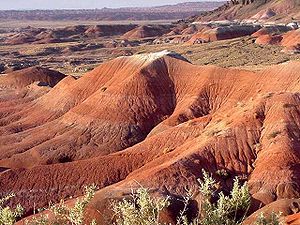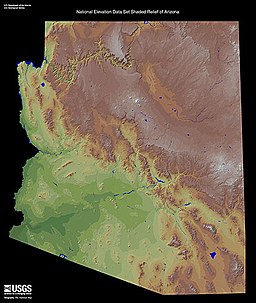Painted Desert (Arizona)
| Painted Desert (El Desierto Pintado) | |
|
Name origin: (Colonial Spanish, 1540) El Desierto Pintado |
|
| Country | United States |
|---|---|
| State | Arizona |
| Part of | Colorado Plateau |
| Borders on | Little Colorado and Puerco rivers |
| Parts | Little Painted Desert County Park (north of Winslow) |
| Coordinates | 35°30′01″N 110°05′02″W / 35.50028°N 110.08389°WCoordinates: 35°30′01″N 110°05′02″W / 35.50028°N 110.08389°W |
| Area | 7,500 sq mi (19,425 km2) |
|
Relief map showing arc-shaped desert north and northeast of Mogollon Plateau and Mogollon Rim.
|
|
The Painted Desert is a United States desert of badlands in the Four Corners area running from near the east end of the Grand Canyon National Park southeast into the Petrified Forest National Park. It is most easily accessed in the north portion of The Petrified Forest National Park. The Painted Desert is known for its brilliant and varied colors, that not only include the more common red rock, but even shades of lavender.
The Painted Desert was named by an expedition under Francisco Vázquez de Coronado on his 1540 quest to find the Seven Cities of Cibola, which he located some forty miles east of The Petrified Forest National Park. Finding the cities were not made of gold, Coronado sent an expedition to find the Colorado River to resupply him. Passing through the wonderland of colors, they named the area "El Desierto Pintado" - The Painted Desert.
Much of the Painted Desert within the Petrified Forest National Park is protected as the Petrified Forest National Wilderness Area where motorized travel is limited. But the park offers both easy and longer hikes into the colored hills. The Painted Desert continues north into the Navajo Nation where off-road travel is by permit.
The desert is composed of stratified layers of easily erodible siltstone, mudstone, and shale of the Triassic Chinle Formation. These fine grained rock layers contain abundant iron and manganese compounds which provide the pigments for the various colors of the region. Thin resistant lacustrine limestone layers and volcanic flows cap the mesas. Numerous layers of silicic volcanic ash occur in the Chinle and provide the silica for the petrified logs of the area. The erosion of these layers has resulted in the formation of the badlands topography of the region.
...
Wikipedia


